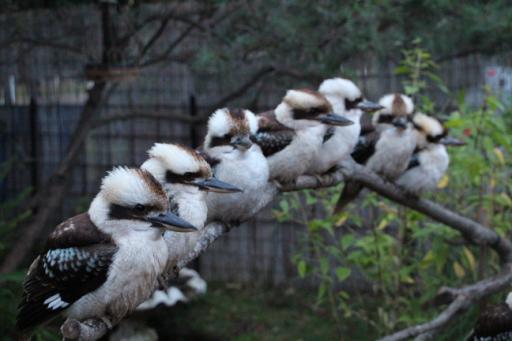
Fun Fact of the day
Learn something every day – funny, strange, interesting, and certainly Corona-free. Have fun!
April
22. 4. 2020 – Kookaburra

Today it will be all about the largest kingfishers in the world, the Kookaburra (see picture). Difficult to imagine that these large birds are the direct relatives of our small bright-blue
kingfishers, with a size of about 40 cm the Kookaburra is more than twice the size of its only European relative.
Kookaburras are living in Australia, along the East-coast from Darwin down to Melbourne as well as in the southwest area around Perth.
Other than the European Kingfisher, the Kookaburra is a meat eater, it mostly preys on mice and other small mammals, large insects (which is no problem in Australia),
snakes which are even larger than itself and even poisonous (so it is brave), and meat from the sandwiches from unsuspicious tourists.
In fact, it is a popular sport for Kookaburras to watch their human targets from a high post and wait for the right moment to dive down and snatch the object of desire from the unsuspecting homo sapiens.
But Kookaburras are not just famous for their larcenous feeding, but also for their "songs": a long drawn-out hysterical laughter, usually sung at dawn and best done as a choir.
Just like a packs song the Kookaburras song starts with one bird singing, and all other chime in. The resulting morning concert renders the acquisition of an alarm clock superfluous.
The Kookaburras song is so distinctive that it even entered film industry as the background sound for jungle scenes, even though the Kookaburra is not a classical jungle bird.
Why does the pack-singing work so well? Well, Kookaburras are monogamous, that is one breeding couple stays together for their lives. And because its more fun if all are together,
young Kookaburras stay with their parents until they start breeding themselves. The young birds help with the new nestlings, and also with defending the territory.
Thus, Kookaburras often live in groups of up to 10 members in one territory. So a pack-song is worthwhile.
The attentive visitor to Australia might even enjoy a special spectacle: If one finds a large pile of bird droppings under a thick tree branch, it pays off to come back in the evening and take a look at that branch. For sleeping, Kookaburras love to sit tightly together on one branch. Group cuddling of the very fluffy kind!
· · · ·
21. 4. 2020 – Tides

Everyone who had vacations at the sea at least once is familiar with the phenomenon of tides: Thanks to the Moon we have high and low tide twice within 25 hours (yes, it takes
more than 24 hours until the Moon sees the same point on Earth again) all over the planet Earth.
And yet the tidal range differs strongly between the various coasts: For example, those who have been to the German Northern Sea Coasts (but also some of the Dutch and Danish Northern Sea Coasts),
know the fun of chasing the water for a swim depending on the tides. The water can withdraw up to 20 km from the coastal line, for example in Cuxhaven.
In total, however, the tidal hight difference is not that large, it only accounts for 2–3 meters at the Northern Sea.
In the Baltic Sea, the difference is even smaller with only 30 cm, and in the Mediterranean Sea it accounts for about 1 meter (for example in Venice) or maximal 2 meters.
Other regions of this planet, however, show much larger hight differences: In the English Channel the hight difference can reach up to 12 meters per tide. The world record on Tidal Heights, however,
goes to Canada: in the Bay of Fundy, in the north-east of Canada between the Provinces of Nova Scotia and New Brunswick, the daily tides reach heights of up to 13–16 meters, with the record being
even more than 21 meters. This can be nicely studied at the Hopewell Rocks (see picture), who stand freely in the mudflat at low tides, but are covered all over but the uppermost
wooded part of the middle rock (these rocks, by the way are between 12 and 20 meters high).
Apart from passionate mudflat walkers (there is a special word in German for this, it is called Wattwandern and is a northern German attraction), this is loved especially by many
kind of birds – who would not love to have the food served freely twice a day on a golden tablet, already delicately salted?
Last update 21. 04. 2020 by Rhea-Silvia